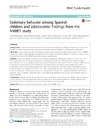Please use this identifier to cite or link to this item:
https://accedacris.ulpgc.es/handle/10553/41598
| Title: | Sedentary behavior among Spanish children and adolescents: findings from the ANIBES study | Authors: | Mielgo-Ayuso, Juan Aparicio-Ugarriza, Raquel Castillo, Adrian Ruiz, Emma Avila, Jose M. Aranceta Bartrina, Javier Gil, Angel Ortega, Rosa M. Serra Majem, Luis Varela-Moreiras, Gregorio González-Gross, Marcela |
UNESCO Clasification: | 3206 Ciencias de la nutrición | Keywords: | Sedentary lifestyle Physical activity Youth Child ANIBES Study |
Issue Date: | 2017 | Journal: | BMC Public Health | Abstract: | Background: An increase of sedentary behaviors far from the Mediterranean lifestyle is happening in spite of the impact on health. The aims of this study were to describe sedentary behaviors in children and adolescents. Methods: A representative sample of 424 Spanish children and adolescents (38% females) involved in the ANIBES study was analyzed regarding their sedentary behaviors, together with the availability of televisions, computers, and consoles by means of the HELENA sedentary behavior questionnaire. Results: For the total sample of children, 49.3% during weekdays and 84% during weekends did not meet the recommendation of less than 2 hours of screen viewing per day. The use of TV was higher during weekdays (p < 0.05) and there were significant differences between adolescents and children (16.9 vs. 25.1%, p < 0.05). The use of computer, console games and of internet for non-study reasons was higher during weekends (p < 0.001). Adolescents played more computer games and used more internet for non-study reasons than children during both weekdays and weekends (p < 0.05 and p < 0.001, respectively). The use of internet for academic reasons was lower in children (p < 0.001) than adolescents during weekends; however, no significant differences were found between sexes. In addition, more than 30% of the children and adolescents had at least one electronic device in their bedrooms. Conclusions: Spanish children and adolescents are not meeting the recommendations regarding the maximum of screen viewing (<2 h/day), especially during the weekend, for all of sedentary behaviors. Urgent strategies and intervention studies are needed to reduce sedentary behavior in young people. | URI: | https://accedacris.ulpgc.es/handle/10553/41598 | ISSN: | 1471-2458 | DOI: | 10.1186/s12889-017-4026-0 | Source: | BMC Public Health [ISSN 1471-2458], v. 17 (1), p. 1-9, article number 94 |
| Appears in Collections: | Artículos |
SCOPUSTM
Citations
43
checked on Jun 8, 2025
WEB OF SCIENCETM
Citations
37
checked on Jun 8, 2025
Page view(s)
71
checked on Sep 16, 2023
Download(s)
87
checked on Sep 16, 2023
Google ScholarTM
Check
Altmetric
Share
Export metadata
Items in accedaCRIS are protected by copyright, with all rights reserved, unless otherwise indicated.
